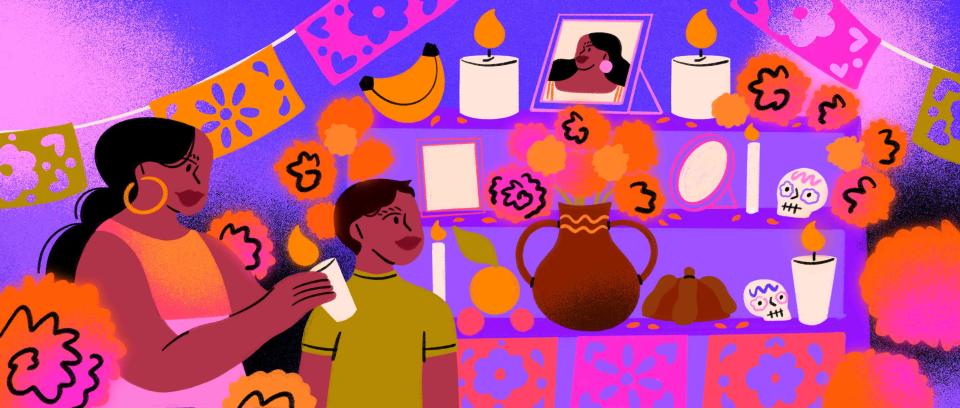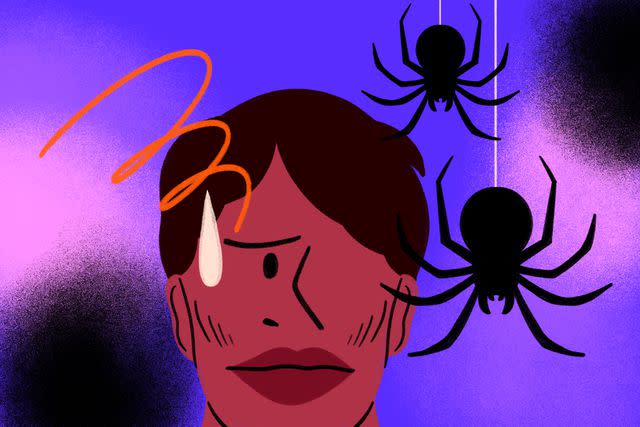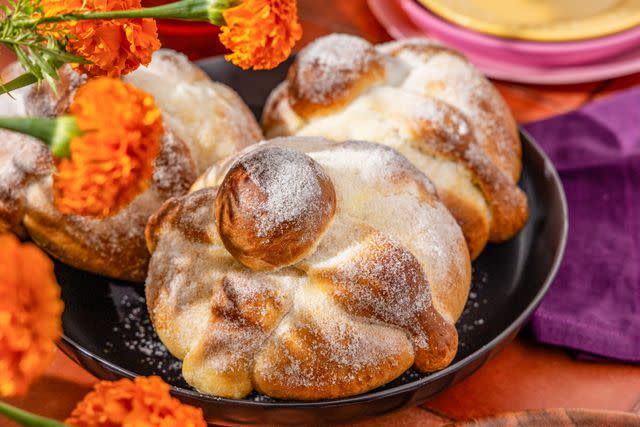On Día de Muertos, the Dead Return To Eat Us
"I finally understood why the dead come back for food. The hunger that guides them is a hunger for us..."

Simply Recipes / Fer Oms / @feroms
In third grade, our class built an altar for Día de Muertos. My stack of tissue paper (to make papel picado) included every color in its most saturated form. If I could have, I would’ve fled with the entire rainbow rack, shrieking in joy through Mexico City’s streets. I folded tissue paper, snipped corners, cut shapes at the edges, and when unfolded—sorcery!—a pattern emerged, unforeseeable and wild. I fell in love with my bright, lacy creations.
Later, my classmates and I delighted in spreading fresh cempasúchil petals to mark a path from the classroom door to the altar. Our teacher and volunteer parents placed pan de muerto, tamales, hot chocolate, and sugar skulls on our pink and purple altar’s tiers. They lit candles. A father set three bottles of Coca-Cola next to a black and white photograph of a woman’s glowing face. Our class learned that we offered food to lure the dead back to us, guided by the candles, the bright orange of the cempasúchil, and every color’s radiating joy.
Coming back to the world of the living to bathe in color made sense to me: the cempasúchil, our papel picado, the brilliantly decorated sugar skulls. But why would the dead travel all the way from the afterlife (somewhere majestically fun, no doubt) to eat food? Food! I was nine, and I didn’t understand why food elicited such a hullabaloo. To me, food was lumpy and gray, gruel disguised as pork chops or broccoli. I ate begrudgingly, if at all.
During dinner—my dad and sister long done and gone—my mom would cross her arms on the table, rest her head on top, and wait for me to finish my plate. I wasn’t allowed to leave until I at least attempted to finish my meal. “Two bites! Come on, one. One!” my mom negotiated against herself. And when I wouldn’t take even one bite, she prayed that sitting at the table for hours would bore me enough to eat.
At nine, I looked like I was six or, if generous, seven. Overly skinny and exceptionally short, my grandma worried I might disappear. She instructed my mom to make me jugo de carne, a rich beef broth with chopped onion, cilantro and drops of lime. Though I love it now, I hated it back then. It sat in front of me, a speckled brown concoction daring me to eat it. I wouldn’t. Instead, when our parents weren’t looking, my sister stole spoonfuls. She enjoyed food wholeheartedly, a mystery to me as my pickiness was a mystery to her. I wondered what it would feel to want to eat like she did, to savor food, its richness and texture, instead of having to force myself to swallow spoonfuls of jugo de carne just so I wouldn’t disappear. I wondered what it was like to hum with pleasure, like when my dad bit the tip of a chile serrano to compliment any mouthful.
Close to my tenth birthday, Día de Muertos past, altars dismantled, Christmas come and gone, spring upon us, I got sick. I couldn’t hold any food down. My fever was so high I hallucinated spiders and a man in a dark brown hat watching me from a corner of the room.

Simply Recipes / Fer Oms / @feroms
I slept with my mom in my parents’ bedroom, my dad banished to mine. My mom kept a close watch on my fever; if it got any higher she was to take me to the ER. Otherwise, the pediatrician said I would come out of the illness on my own—my body strong enough (or somehow able to summon enough fight) to destroy the virus. My mom fed me Tempra and bathed me in cool water, keeping me at the border of manageable fever, trying to prevent the leap into dash-to-the-hospital burning up.
Was I dying? Probably.
But I trusted my mom and dad wouldn’t let me die.
Even when my mom assured me no spiders crawled across the room’s walls and no man in a brown hat stared at me from the corner. Even when I threw up apple juice. Even when I threw up water. Even when I could tell my parents were terrified, I wasn’t afraid. I was suddenly hungry! So, so very hungry. A desire so strong it was like my stomach was screaming: part illness groan, part mischievous wail of need. Food! My body clamored to survive.
During the two weeks death teased me, I discovered the feeling of craving food. Hunger grounded me back into a body I felt ebbing. I dreamt of my mom’s beef and bacon rolls, of quesadillas, smoked pork chops, mashed potatoes, and, above all, pan de muerto. I fantasized about dunking a piece in cold milk, biting and slurping the wet sugary crumbs dripping down my chin. I was finally able to imagine what it would feel like to enjoy food.
Life rebooted, hunger burst alive inside me. Hunger screamed BODY NEEDS NOURISHMENT, but more than that, in a quieter though stupendous tone, hunger reaffirmed I had a life yet to live, my family to enjoy. I was hungry to be alive, and eating, rather than a chore, became an affirmation: today, I live. I discovered that food not only provided the nutrients necessary to keep me biologically viable, it offered the love in my mom’s hands, my dad’s passion as he engaged us in conversation, my sister’s unbridled joy.
On Día de Muertos, we offer the dead our food, not to satiate a bodily need—what function would nutrients serve the dead? We offer ourselves, love passed on through hands that wrap a tamal, scoop tinga, dab salsa on a taco, open a beer. Our shared joy is cooked, steamed, baked and fried into each bite. I finally understood why the dead come back for food. The hunger that guides them is a hunger for us, a hunger to reconnect through the tastiest and most bodily of ways: food.
When I’m dead, my plan on Día de Muertos is to visit my cherished living ones, eat pan de muerto, dunk it in a café con leche, and replenish myself with delicious love.
Get Recipe with Title: My Mom Is a Baker and Her Pan de Muerto Is Joy

Simply Recipes / Mark Beahm
Read the original article on Simply Recipes.

